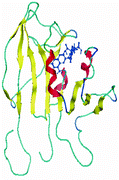A proposed model of Mycobacterium avium complex dihydrofolate reductase and its utility for drug design†
Abstract
A homology model of Mycobacterium avium complex dihydrofolate reductase (MAC DHFR) was constructed on the basis of the X-ray crystal structure of Mycobacterium tuberculosis
(Mtb) DHFR. The homology searching of the MAC DHFR resulted in the identification of the Mtb DHFR structure (PDB 1DF7) as the template for the model building. The MAC enzyme sequence was aligned to that of the Mtb counterpart using a modified Needleman and Wunsch methodology. The initial geometry to be modeled was copied from the template, either fully or partially depending on whether the residues were conserved or not, respectively. Using a randomized modeling procedure, 10 independent models of the target


 Please wait while we load your content...
Please wait while we load your content...